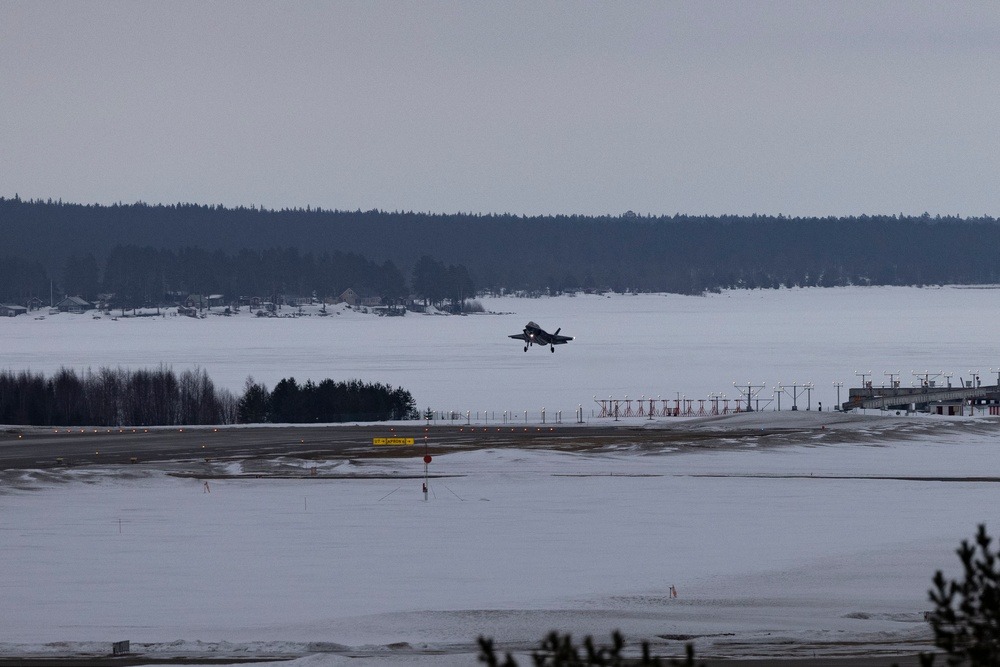
Captain Jacob Sugg USMC, Exercise Nordic Response Media Information Center
15 Mar 2024
LULEA, Sweden–Four U.S. Marine Corps F-35B Lightning II Joint Strike Fighters with Marine Fighter Attack Squadron 542, 2nd Marine Aircraft Wing, and a KC-130J Super Hercules with Marine Aerial Refueler Transport Squadron 252, 2nd MAW, conducted distributed aviation operations during Exercise Nordic Response 24 at Kallax Air Base in Lulea, Sweden, March 13, 2024.
Exercise Nordic Response, formerly known as Cold Response, is a NATO training event conducted every two years to promote military competency in arctic environments and to foster interoperability between the Marine Corps and allied nations.
The event marked the first time a U.S. F-35 Lightning II jet aircraft landed in Sweden, the first time any F-35 operated at Kallax Air Base, and one of the first training events conducted by Sweden as a NATO member.
“We’re thrilled to welcome the first American F-35 landing here at Kallax air force base, and it’s an F-35B from the U.S. Marine Corps,” said Swedish Brig. Gen. Tommy Petersson, deputy commander of the Swedish Air Force. “For the U.S. Marine Corps of course, it’s a part of the agile combat employment portion in the framework of the exercise we’re conducting together right now, Nordic Response 24.”
The preplanned event provided an opportunity for U.S. Marine Corps aviation platforms to use a Swedish air base and host-nation support to conduct aviation-delivered ground refueling from a U.S. KC-130J Super Hercules to U.S. F-35B JSF aircraft.
“Of course, this is of vital interest for Sweden as a new ally in NATO to further develop our ability for host-nation support, for instance for American assets,” said Petersson.
Distributed aviation operations is a method of generating aviation combat power through the coordinated employment of aviation squadrons, command-and-control agencies, aviation logistics, and aviation ground-support units disaggregated across the battlefield that challenges adversary targeting efforts. The 2nd MAW concept of DAO distributes command and control of aviation forces across echelons of command, pushing authorities to the lowest levels, while keeping forces moving between airfields and air sites. It also integrates and builds interdependencies between the 2nd MAW and its allies and partners.
“This is an opportunity to work with our Swedish partners to exercise distributed aviation operations,” said U.S. Maj. Gen. Scott Benedict, commanding general of 2nd MAW. “We were able to launch our aircraft into a NATO training strike package, recover them back here in Sweden, refuel them via expeditionary means out of a KC-130, and get them back in the air for another sortie. This is our means to be able to operate in an environment where we are protected because of our mobility.”
Both VMFA-542 and VMGR-252 deployed from their home base of Marine Corps Air Station Cherry Point, North Carolina. VMFA-542 is the first East Coast operational F-35 squadron for the U.S. Marine Corps. Exercise Nordic Response 24 was VMFA-542’s first overseas exercise as an F-35B Lightning II jet squadron and since achieving initial operational capability on Feb. 5, 2024.
During the exercise, VMFA-542 employed its fifth-generation assets in a near-peer adversary training exercise while advancing and sustaining the squadron in core mission-essential tasks of anti-air warfare, active air defense, suppression-of-enemy air defense, and strike capabilities while progressing the squadron toward full operational capability. The squadron integrated with NATO allies across Northern Europe and with United Kingdom and Norwegian F-35 aircraft, showcasing the breadth and diversity of the Joint Strike Fighter program.
Throughout the exercise, VMGR-252 employed its KC-130J Super Hercules aircraft to support Marine Air-Ground Task Force objectives such as providing transportation of cargo, combat-assault transport, aerial refueling, and aviation-delivered ground refueling to both U.S. and allied aircraft. They conducted aviation operations from expeditionary shore-based sites and cold-weather conditions to achieve training objectives and increase aircrew and loadmaster proficiencies.
Exercise Nordic Response 24 was a two-week exercise that brought together NATO allies and partners for a comprehensive demonstration of military prowess across land, maritime, and aviation domains. Against the backdrop of challenging arctic and mountainous conditions, participating military forces engaged in realistic force-on-force scenarios, showcasing their capabilities in both offensive and defensive operations.
“Our allies and partners have been living in this region for a long time, and they’ve developed similar capabilities themselves,” said Benedict. “As we partner with allies, it enables us to exercise what to do better and to learn from their experience operating here. We’re always better working together; opportunities to enable our concepts and operations alongside partners, while learning, gets the best of both worlds.”
Exercise Nordic Response 24 is a continuation of the record-breaking NATO exercise Steadfast Defender.
B-roll, imagery, and news stories of II MEF Marines participating in Exercise Nordic Response 24 can be found hyperlinked on the Exercise Nordic Response DVIDS page.
- Red Sea Update - April 26, 2024
- U.S. Begins Construction on Temporary Pier to Deliver Humanitarian Aid to Gaza - April 26, 2024
- IKE Carrier Strike Group Arrives in the Eastern Mediterranean - April 26, 2024






